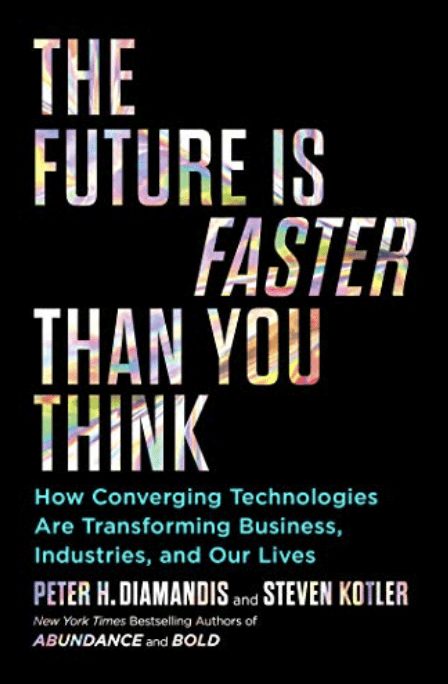Read the Report | by Peter Long
My father always used to say: “Don’t let the people who say it cannot be done, get in the way of the people doing it!” At this moment in our Nation’s history, I feel like these words have never been more profound. Our daily lives are currently filled with so much drama and constant negativity. The nightly news seems to be a full-throated, non-stop repetitive movie on all the things that are wrong in the world. Regardless of your political affiliations, this negativity seems to be omnipresent.
So, are you ready for a mind-opening and incredibly uplifting view of the world? Do you want to see what is REALLY happening all around us? If you do, then you need to read The Future is Faster Than You Think by Peter Diamandis and Steven Kotler. Whether you are a teacher, a business professional, a company owner, a student, or just a person that needs a break from the study of dark matter, this book is guaranteed to make you reassess many of your preconceived thoughts on where the world is heading.
This book single handedly inspired me, a business owner, to pivot my company’s entire strategic plan. It has made me realize that as a leader I need to make myself much more aware of, as my dad would say, “the people doing it.” The world’s most famous ice hockey player, Wayne Gretzky, once said, “A good hockey player is where the puck is. A great hockey player is where the puck is going to be!” Understanding where technology, jobs, opportunities, and investment income are going to be, is fundamentally what this book is all about. For me, it inspired a personal journey to re-engineer my company so we end up where the proverbial business opportunity “puck” will be (new opportunities, new customers, solving new needs, etc.). The time of just chasing our competitors’ next moves and being a dollar short and a minute late is officially over.
The book is constructed into two separate sections. The first section of the book is a detailed look at the obvious but unseen speed of converging technological change. All of us are experiencing this in every segment of our lives. But we all frequently get overly fixated on the single tree, and as a result, completely lose sight of the vast forest it lives in. At one time or another, all of us have seen an example of hidden images inside of a picture. The most famous of these is the invisible face of the old lady hidden in the painting of a young woman. One might look at the painting for many minutes and not see the hidden figure of the old woman. But once seen, it becomes the central object that is so obvious from that point forward. So, when I previously said, “obvious but unseen,” it is because the many technological improvements we see are all obvious to us. But we tend to look at each of them as a singular, distinct, and separate technological item of improvement, not as a unifying converging platform of innovations that is accelerating change and will continue to accelerate future changes at an even faster pace. Once you see it and understand it, you will not be able to look at the world the same way again.
It is hard to believe that the modern internet, mobile phones, Google, Twitter, Facebook, consumer GPS maps, opensource programming code, fiber optics, Amazon, cloud-based computing technology, private access to virtually infinite computing power, private space travel, lithium-ion batteries, and many more technologies are all less than 30 years old. Many of these mentioned innovations are actually less than 10 years old. Anyone of these spectacular innovations is immensely impressive and we typically view them and learn about them as a robust case study on their own singular merits. But the author is more focused on the “convergence” of all these different technologies. This convergence is what is transforming the world and it is changing virtually everything we do. It is all happening at an ever-faster accelerating pace and it is fundamentally unstoppable. What do I mean by unstoppable? Here is a simple example: When electric cars can drive 5,000 miles on a single charge, will fully recharge in less than an hour, last longer, have fewer maintenance needs, drive faster, have more power, and will actually be cheaper to buy than traditional cars, then how can their adoption over traditional gasoline-powered cars be stopped? How can this not transform what we drive? The thing is, that this reality is not that far off.
But the key point in all this and where the title becomes the prediction of the future. What we are seeing now—today—is only the opening movie credits in this real-life movie of change. The real movie has not even started yet! What we will see innovated in the next 20 to 30 years will absolutely dwarf what has happened in the past 20 to 30 years. This is because the converging sets of technologies are allowing massive acceleration in innovation. I think we all intuitively understand this, but maybe do not spend as much time pondering its effects on us. The changes that are coming will just keep accelerating as more and more technological convergence takes hold. Creating more jobs, creating new industries, allowing the small player to be huge, obsolescing old industries at a faster and faster pace, solving more impossible medical and other mysteries. In short, we are entering an unprecedented time of change, scale of opportunity and the ability to solve some of the most pressing and difficult problems our earth faces. So, what are the key divers we need to emulate and understand?
The modern Silicon Valley investment fund now looks for companies that are on the path of the six D’s—digitalization, deception, disruption, demonetization, dematerialization, democratization. I am writing this review for edWeb’s newsletter and they are a perfect example of a six-D company! “Digitalization” of their content allows edWeb to ride Moore’s Law on scalability. When edWeb was first starting out it was small and “deceptive” with its free PD content and just a few members using the service. So, this made edWeb a threat to no one which allowed edWeb time to grow and get strong. Eventually, the free access to all its PD content began to “disrupt” traditional PD business models as more and more educators gained access to a preferred free solution that was more comprehensive and easier to consume. This has led to older more expensive paid-to-play PD business models begin to be “demonetized” which means they are forced to confront the fundamental shift in their business model or eventually die. Once information and learning have been “dematerialized” industrywide (meaning free to everyone) and “democratized” industrywide (meaning available to everyone) you have completed the circle of an entire industry transformation. This type of transformation is happening all around us—YouTube self-help videos, Khan Academy, product reviews on Amazon, free phone service on Zoom, 2,000,000 free apps available on your iPhone, and many, many more. A world where knowledge sharing is comprehensive, free, and accessible to all is truly a global transformational change.
The second major segment of the book is the study of what kinds of changes are coming. A chapter-by-chapter description covering the future of: Education, Healthcare, Food, Transportation, Shopping, Entertainment, and many more. This is an eye-opening and fun read for sure. There is likely some area of interest for every reader, teacher, doctor, student, business owner, etc. While I certainly enjoyed this section, it was really section one that opened my eyes. Think of this section as the official “taste test” of the recipe everyone was just given. A showcase, for example, of how the converging technologies of cloud computing, digital GPS, artificial intelligence, machine learning, and high-resolution imagery cameras can make a driverless car far safer than a human-operated car. The list of innovations is impressive, and I am sure does not even scratch the surface of what is to come.
To conclude, this is an important book and one that should inspire all of us. In an era where we are constantly fed news on how so many issues are dire and we are stuck listening to all the things that “can’t be done,” technology and the changes coming have the real potential to be what improves all things. If reading this book does anything, I hope it makes all of us more interested in engaging, following, and listening to the “people who are getting it done” and will help all of us to start the move to “where the puck is going to be.”
Reach out to Peter Long by email or on LinkedIn to learn more.
MCH Strategic Data is a leading provider of data and technology solutions. MCH’s commitment to providing superior solutions is evidenced by ongoing investment in people, data, technology, and services, and the passion, experience, and dedication of MCH’s employees. Learn more at https://www.mchdata.com/about
K-12 Education’s Plans for Fall 2020 – IESD and MCH Strategic Data
COVID-19 IMPACT: School District Status Updates for Fall 2020 – MCH Strategic Data and ESRI
Peter Long serves as Chief Executive Officer for MCH Strategic Data.
Mr. Long has over 30 years of experience in business administration, database analytics, and sales management. As CEO, Peter is responsible for leading and overseeing the 80-year-old company in the areas of business development, research, information technology, marketing, and client services. He is an instrumental force in MCH’s continued growth and in the acquisition of two first-class companies that fit MCH’s brand and market: QED Education Database in 2010, and the industry-leading early childhood database market research firm, Wilson Marketing Group, in 2011.




